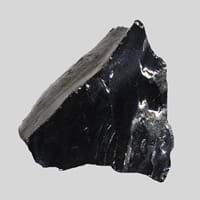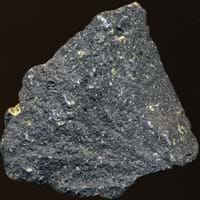Definition
Anthracite is a type of sedimentary rock which is hard and is variety of coal that has high luster
Basalt is a common extrusive igneous rock formed by the rapid cooling of basaltic lava exposed at or very near the surface of Earth
Origin
Pennsylvania, U.S.
Egypt
Discoverer
Unknown
Georgius Agricola
Etymology
From Greek anthrakites, from anthrax, anthrak meaning coal
From Late Latin Basaltes (variant of basanites ), very hard stone, which was imported from Ancient Greek Basanites
Class
Metamorphic Rocks
Igneous Rocks
Sub-Class
Durable Rock, Soft Rock
Durable Rock, Medium Hardness Rock
Group
Not Applicable
Volcanic
Other Categories
Coarse Grained Rock, Fine Grained Rock, Medium Grained Rock, Opaque Rock
Fine Grained Rock, Opaque Rock
Texture
Amorphous, Glassy
Glassy, Massive, Porphyritic, Scoriaceous, Vesicular
Color
Black, Brown, Dark Brown, Grey, Light to Dark Grey
Black, Brown, Light to Dark Grey
Durability
Durable
Durable
Appearance
Veined or Pebbled
Dull and Soft
Interior Uses
Not Yet Used
Floor Tiles, Homes, Hotels, Kitchens
Exterior Uses
Not Yet Used
As Building Stone, Paving Stone, Garden Decoration, Office Buildings
Other Architectural Uses
Not Yet Used
Curbing, Whetstones
Construction Industry
Cement Manufacture, for Road Aggregate, Making natural cement, Steel Production
Arrowheads, As Dimension Stone, Cobblestones, Cutting Tool, Rail Track Ballast, Roadstone
Medical Industry
In Chemical and Pharmaceutical Industry, Manufacture of Aspirins
Not Yet Used
Antiquity Uses
Not Yet Used
Artifacts, Monuments
Commercial Uses
Alumina Refineries, Electricity Generation, Liquid Fuel, Manufacture of Soap, Solvents, Dyes, Plastics and Fibres, Paper Industry
An Oil and Gas Reservoir, Commemorative Tablets, Creating Artwork, Used in aquariums
Types
Semi-anthracite and Meta-anthracite
Alkaline Basalt, Boninite, High Alumina Basalt, Mid Ocean Ridge Basalt (MORB), Tholeiitic Basalt, Basaltic trachyandesite, Mugearite and Shoshonite
Features
Helps in production of Heat and Electricity, Used as fossil fuel
Has High structural resistance against erosion and climate, Very fine grained rock
Archaeological Significance
Monuments
Not Yet Used
Used
Famous Monuments
Not Applicable
Easter Island in the Polynesian Triangle, Pacific Ocean, Gateway of India in Mumbai, India, Gol Gumbaz in Karnataka, India
Sculpture
Not Yet Used
Used
Famous Sculptures
Not Applicable
Data Not Available
Figurines
Not Yet Used
Used
Formation
Anthracite forms from the accumulation of plant debris in a swamp environment. When plant debris dies and falls into the swamp, the standing water of the swamp protects it from decay.
Basalt forms when lava reaches the Earth's surface near an active volcano. The temperature of lava is between 1100 to 1250° C when it gets to the surface.
Mineral Content
Calcite, Clay, Clay Minerals
Olivine, Plagioclase, Pyroxene
Compound Content
Carbon, Hydrogen, Nitrogen, Oxygen, Sulphur
Aluminium Oxide, CaO, Iron(III) Oxide, FeO, Potassium Oxide, MgO, MnO, Sodium Oxide, Phosphorus Pentoxide, Silicon Dioxide, Titanium Dioxide
Types of Metamorphism
Burial Metamorphism, Contact Metamorphism, Regional Metamorphism
Contact Metamorphism
Types of Weathering
Not Applicable
Biological Weathering
Types of Erosion
Not Applicable
Not Available
Grain Size
Medium to Fine Coarse Grained
Fine Grained
Fracture
Conchoidal
Conchoidal
Streak
Black
White to Grey
Porosity
Less Porous
Less Porous
Luster
Shiny
Not Available
Compressive Strength
Not Available
Cleavage
Non-Existent
Not Available
Toughness
Not Available
2.3
Specific Gravity
1.1-1.4
2.8-3
Transparency
Opaque
Opaque
Density
1.25-2.5 g/cm3
2.9-3.1 g/cm3
Resistance
Heat Resistant, Water Resistant
Heat Resistant, Pressure Resistant, Wear Resistant
Deposits in Eastern Continents
Asia
Bangladesh, Burma, Cambodia, China, India, Indonesia, Kazakhstan, Malaysia, Mongolia, Pakistan, Turkey, Vietnam
India, Russia
Africa
Botswana, Kenya, Morocco, Mozambique, South Africa, Tanzania
South Africa
Europe
Belgium, Bulgaria, England, France, Germany, Greece, Hungary, Kosovo, Netherlands, Norway, Poland, Romania, Serbia, Slovakia, Slovenia, The Czech Republic, Ukraine, United Kingdom
Iceland
Others
Not Yet Found
Not Yet Found
Deposits in Western Continents
North America
Canada, Mexico, USA
Canada, USA
South America
Brazil, Chile, Colombia, Venezuela
Brazil
Deposits in Oceania Continent
Australia
New South Wales, Queensland, Victoria
Not Yet Found
All about Anthracite and Basalt Properties
Know all about Anthracite and Basalt properties here. All properties of rocks are important as they define the type of rock and its application. Anthracite belongs to Metamorphic Rocks while Basalt belongs to Igneous Rocks.Texture of Anthracite is Amorphous, Glassy whereas that of Basalt is Glassy, Massive, Porphyritic, Scoriaceous, Vesicular. Anthracite appears Veined or Pebbled and Basalt appears Dull and Soft. The luster of Anthracite is shiny while that of Basalt is not available. Anthracite and Basalt are available in black, brown, dark brown, grey, light to dark grey colors. The commercial uses of Anthracite are alumina refineries, electricity generation, liquid fuel, manufacture of soap, solvents, dyes, plastics and fibres, paper industry and that of Basalt are an oil and gas reservoir, commemorative tablets, creating artwork, used in aquariums.










